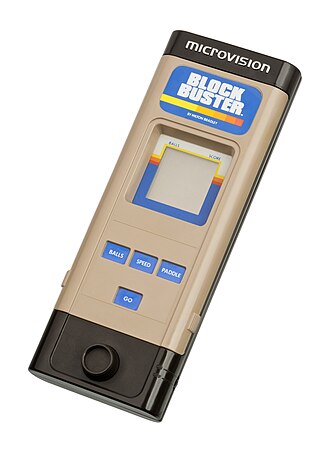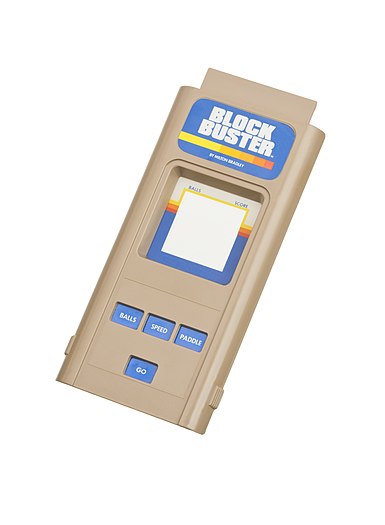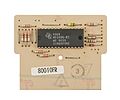History of video games/Platforms/Microvision
-
A Microvision handheld game console. The device is rather large compared to later handhelds.
History
[edit | edit source]Development
[edit | edit source]Milton Bradley was founded in 1860 to make board games[1], making it one of the oldest companies to have a major impact in the video game industry.
Jay Smith designed the Microvision and would later design the Vectrex.[2][3]
Launch
[edit | edit source]
The 1979 release of the Microvision was the first major portable console to use swappable cartridges, allowing a single system to play multiple games.[3]
The Microvision is seen in the 1981 movie Friday the 13th Part 2, a significant early appearance of a handheld game console in popular culture.[4][5]
Legacy
[edit | edit source]The Microvision was discontinued in 1981[4][6], though one game saw a Europe only release in 1982.[2] The failings of the Microvision design were lessons for Nintendo employees during the design of Game and Watch and Game Boy consoles.[7][8]
Technology
[edit | edit source]
Unlike most modern consoles but similar to many other consoles at the time, the Microvision contained processing elements on each game cartridge, not the console itself, though the clock speed used was always at 100 kilohertz (0.1 megahertz).[2] Cartridges either used an Intel 8021 CPU or a Texas Instruments TMS1100 CPU.[9]
The Microvision had a grey and black LCD with a resolution of 16 pixels by 16 pixels, and a size of 2 inches.[2][3] The screen ages poorly, and is prone to damage from screen rot.[10]
Cartridges were known to be quite fragile and especially vulnrable to electrostatic discharge.[11][12]
Early Microvision consoles required two 9 volt batteries, though later models only required a single 9 volt battery.[2]
Notable games
[edit | edit source]
1979
[edit | edit source]- Block Buster
- Bowling
- Baseball
- Connect Four
- Mindbuster
- Pinball
- Star Trek: Phaser Strike
- Vegas Slots
1980
[edit | edit source]- Baseball
- Sea Duel
1981
[edit | edit source]- Alien Raders
- Cosmic Hunter
1982
[edit | edit source]- Super Block Buster
Gallery
[edit | edit source]Microvision Console
[edit | edit source]Microvision Games
[edit | edit source]-
A Microvision game.
-
The back of a Microvision game.
Internals
[edit | edit source]External Resources
[edit | edit source]- Computer History Museum - Microvision page.
- Centre for Computing History - Microvision page.
- Video Game Kraken - Microvision page.
- Handheld Museum - Microvision page.
References
[edit | edit source]| Parts of this page are based on materials from: Wikipedia: the free encyclopedia. |
- ↑ Lepore, Jill. "The Meaning of Life". The New Yorker. Retrieved 17 November 2020.
- ↑ a b c d e "Microvision Console Review". videogamecritic.com. Retrieved 26 October 2020.
- ↑ a b c "Microvision from Milton Bradley - IGN". Retrieved 26 October 2020.
- ↑ a b "History of Consoles-Microvision (1979) Gamester 81". Retrieved 26 October 2020.
- ↑ "Milton Bradley Microvision in Friday the 13th Part II". www.handheldmuseum.com. Retrieved 26 October 2020.
- ↑ "Milton Bradley Microvison (1979 - 1981)". Museum of Obsolete Media. 27 September 2013. Retrieved 28 October 2020.
- ↑ Barder, Ollie. "New Interview With Satoru Okada Delves Into The Hidden History Behind Nintendo's Gaming Handhelds". Forbes. Retrieved 3 December 2020.
- ↑ "Japanese Nintendo". Japanese Nintendo. 29 December 2016. Retrieved 3 December 2020.
- ↑ "MB Microvision - Intel 8021 inside?". AtariAge Forums. Retrieved 20 December 2020.
- ↑ Fletch, Toxic (10 December 2014). "Toxic Fletch: That Handheld Game in Friday the 13th Part 2". Toxic Fletch. Retrieved 26 October 2020.
- ↑ "The Marvelous MicroVision Handheld Videogame". Retro Thing. https://www.retrothing.com/2006/01/the_marvelous_m.html.
- ↑ "Milton Bradley Microvision (1979 - 1981)". Museum of Obsolete Media. 27 September 2013. Retrieved 6 February 2022.
















